Hitachi vs. Western Digital vs. Seagate: A Battle of the Mammoths
by Purav Sanghani on December 2, 2005 12:05 AM EST- Posted in
- Storage
Real World Tests
Synthetic benchmarks are not always the best gauge in measuring the "real" performance of hardware, which is why we have incorporated a few real world tests in our storage reviews. One of our tests, the file system performance test, measures the drive's ability to handle file zip, unzip, and copy operations. This is a great measure of how one drive compares to another and we have put together a group of tasks that most of us typically use.
File System Tasks Within Drive
Synthetic benchmarks are not always the best gauge in measuring the "real" performance of hardware, which is why we have incorporated a few real world tests in our storage reviews. One of our tests, the file system performance test, measures the drive's ability to handle file zip, unzip, and copy operations. This is a great measure of how one drive compares to another and we have put together a group of tasks that most of us typically use.
File System Tasks Within Drive
- File Zip Test - We take a 300MB file and measure the time that it takes for our test bed to compress it to ZIP format. We then run the test again with 300 1MB files to see how the drive performs when working with multiple files.
- File Unzip Test - Using the same methodology as the File Zip Test, we take a ZIP file of a single 300MB file as well as a ZIP file of 300 1MB files and measure the time that it takes to uncompress each ZIP successfully.
- File Copy Test - We measure how long it takes for the system with our test drive to copy a single 300MB file as well as 300 1MB files.
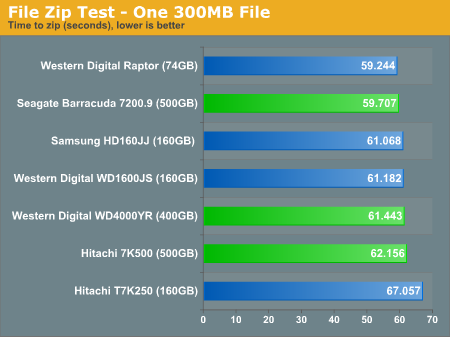
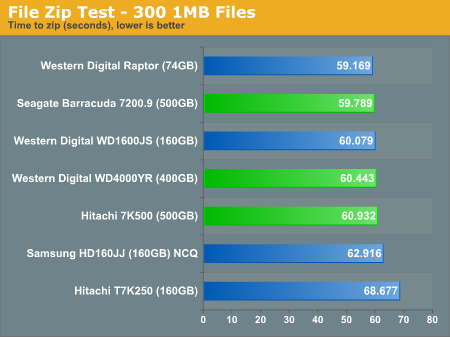

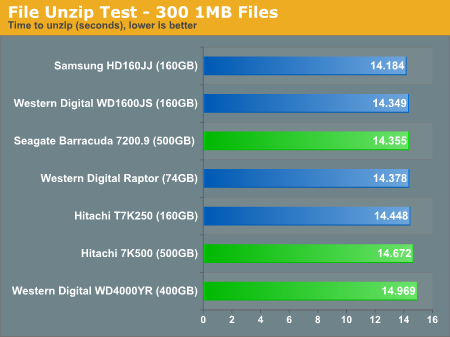
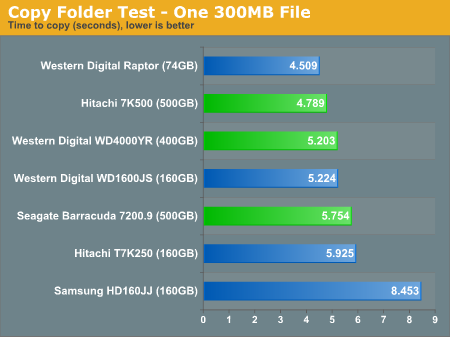
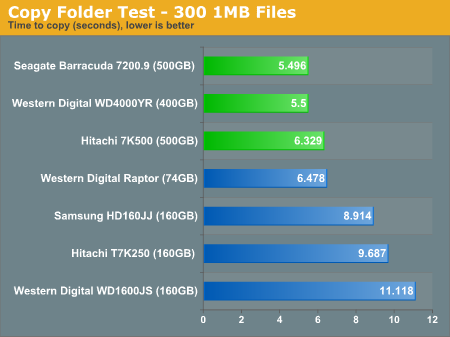
The File Zip/Unzip tests are more dependent on the CPU than the File Copy tests which is why we see the extremely close results. The File Copy test shows Hitachi's 7K500 performing slightly quicker than the Seagate and Western Digital drives.










46 Comments
View All Comments
artifex - Friday, December 9, 2005 - link
Heat? MTBF? Warranty?grnmyeyes - Monday, December 5, 2005 - link
1. Why use the WD4000YR (RE2) instead of the WD4000KD (SE16)? From what I gather, the RE2 is optimized for RAID configurations while the SE 16 is intended for general single-drive use.2. While the review states that the nForce4 motherboard used for testing supports TCQ and NCQ, it neglects to mention whether these features are enabled on all the drives tested. If other sites (storagereview.com) are to be believed, turning off TCQ/NCQ can result in a substantial performance increase for single-user applications.
3. This last one isn't really a flaw, but it would be nice to see the Maxtor DiamondMax 11 put through this same test suite when it becomes available in the near future, since it is designed to compete with these three drives.
NightCrawler - Sunday, December 4, 2005 - link
http://storagereview.com/php/cms/cms.php?loc=news_...">http://storagereview.com/php/cms/cms.php?loc=news_...1. First, the WD4000YR (that is, the “Raid Edition 2”) enjoys a 24-hour factory burn-in period versus the WD4000KD (the “Special Edition 16”)’s 8-hour test. The longer validation cycle increases the chances that a drive destined to suffer an “infant mortality” of sorts is caught at the factory before it enters distribution.
2. Next, the YR features a longer 5-year warranty more typical of enterprise-oriented drives such as WD’s own Raptor or Seagate’s Cheetah series rather than the shorter 3-year coverage that backs the KD.
3. Finally, the RE2, living up to its moniker, ships with the firm’s “Time Limited Error Recovery” (TLER) feature enabled while the SE16 does not. This oft-confusing feature permits a drive to gracefully surrender error recovery features after an 8-second window of attempts rather than stubbornly continuing onwards with the assumption that an array’s redundancy features will cover the error and avoid data corruption. For drives that find themselves in a setup that features redundancy (anything other than RAID 0), this is a plus. For disks that don’t, it’s not.
This leveraged technology between the RE2/SE16 and the Raptor leads WD to boldly proclaim that the WD4000YR can sustain use in a 24 hour a day, 7 day a week environment with its actuator seeking 100% of the time… the only such claim for any 7200 RPM drive on the market. Competing drives such the Seagate NL35 and Maxtor MaXLine Pro, while offering 24x7 power up, are more cautious in duty cycle (that is, seek) claims- “nearline duty loads” for the Seagate and “40%-50%” for the Maxtor.
Worth the $20 extra to get the YR version and the 5 year warranty.
bluefmc - Friday, December 2, 2005 - link
Purav,The WD hard drive you tested is not recommended by WD to be used attached to a non-RAID controller. To quote the StorageReview.com article:
"In fact, WD touts the drive's "Time Limited Error Recovery" (TLER) ability, a feature that enables better drive-controller coordination in mutually handling drive errors. The drawback, however, is that the RE2 expects to operate off of a RAID controller and is as a result not recommended for use in a standard desktop system."
You can read about this in a WD PDF at [L=http://www.wdc.com/en/library/sata/2579-001098.pdf]http://www.wdc.com/en/lib
ary/sata/2579-001098.pdf[/L} Basically it says that if this drive is used attached to a non-RAID controller data corruption may result.
irev210 - Friday, December 2, 2005 - link
Big woopty deal.Go buy a WD4000KD
Besides, the SE16 is cheaper than the RE anyway.
https://www.zipzoomfly.com/jsp/ProductDetail.jsp?P...">https://www.zipzoomfly.com/jsp/ProductDetail.jsp?P...
199 at zipzzomfly with free 2nd day air. An absolute bargain!
bluefmc - Friday, December 2, 2005 - link
It's is actually a big "woopty deal." If someone buys this drive to use as a desktop drive connected to a non-RAID controller it can result in data corrution and/or data loss. This drive is intended solely for use in a RAID array connected to a RAID controller. The article made no mention of this fact, so I thought I'd point it out.phanna - Saturday, December 3, 2005 - link
From the PDF you posted: "A drive under a continuous I/O load and performing its own error recovery can easily exceed 8 seconds of timeout, during which the normal desktop hard drive does not respond".These drives are fine to use as desktop drives. The only thing this sheet is saying is if you do have this connected to a RAID controller, and you are using it in a high load environment, you don't have to worry about it being dropped by the controller if the drive has to perform lengthy error recovery, due to its TLER technology.
irev210 - Saturday, December 3, 2005 - link
exactly!
bluefmc - Saturday, December 3, 2005 - link
Let me explain a problem that has been popping up recently with the growing popularity of SATA RAID. Most SATA drives are not made for use in RAID arrays and are made for desktop use. What this means is that they will take as long as they need to recover from an error. Normally this is a good thing. This becomes a problem when such a drive is hooked up to a RAID controller, since while fixing an error a drive is non-responsive. If a drive is non-responsive for more than approximately 8 seconds, the RAID controller assumes that the drive is dead and fails it out of the array. As a result a perfectly good drive is kicked out of the array for no reason and you now have a lengthy rebuild process to go through.This new drive from WD solves this problem by only trying to fix an error for 8 seconds, then giving up and passing the error along to the RAID controller. With any level of RAID with the exception of 0 you will have no data loss or corruption, and you won't needlessly fail a perfectly good drive out of the array.
Now if this drive is not hooked up to a RAID controller and it gives up on an error in 8 seconds that may have been repairable by the drive in 10, 20, 30 seconds or more, data corruption will result. And yes these longer errors do happen with some frequency. Hence if you do not use this drive in a RAID array that has redundancy, you run a risk of losing data.
Now I want to be clear that I'm not putting down WD or their drives. I'm running 2 WDs in my desktop now myself. I just want people to understand that this drive in not suitable for typical desktop use. This drive must be used in a RAID array of level 1 or higher.
irev210 - Saturday, December 3, 2005 - link
Yup, so i guess we can say that anandtech should have mentioned - BUY the SE16 which is CHEAPER anyway if you dont plan to run a raid, otherwise you could have unneeded problems down the line.Makes sense to me.
Good info bluefmc